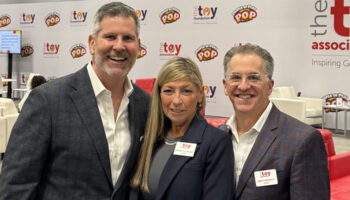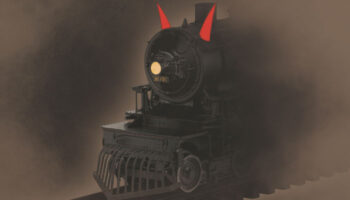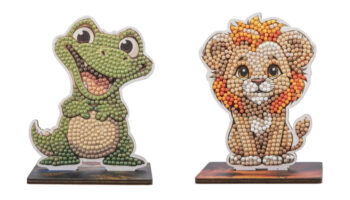Asmodee’s Julien Sharp on what to do to help games cut through the noise

Julien, it’s great to connect. You have a lot of experience in design and working with inventors, as well as on the commercial side of things. How did you get into the industry?
Games are my second career, though my first one also involved games! I earned a degree in business and studied vocal performance on the side. Being a singer with a business degree led me to the cruise industry, where I became a cruise director, running onboard entertainment and activities.
How did games fit into this world?
Our success was measured by how likely guests were to recommend us – a form of Net Promoter Score, though they did not call it that at the time. Our salaries were reflective of scoring, so if something like rain threatened a cruise, we had to get creative! My team would invent fun group games inside to keep guests entertained. This sparked my passion for game design.
Smart! And how did you pivot from that world to board games?
A short time after I left the cruise industry, I founded Funnybone Toys with a business partner. We were keen on games but even more excited about innovative packaging. We started with card games like Spectrix, Array, and CUBU, and unexpectedly expanded into major retailers like Barnes & Noble after our first NY Toy Fair in 2012. With limited resources, I even spent a week in the warehouse to help prepare those big orders. This firsthand experience helps me relate to my warehouse team today.

Amazing. You’re now General Manager for the US at Asmodee. Has that experience of crafting your own games shaped how you approach this role at Asmodee?
These experiences have taught me the value of demanding work in every aspect, even down to naming a game. They have given me resilience, especially when presenting, having spent time selling games at trade shows. When evaluating whether a game fits our market, I understand and empathize with the designers or studios involved. My primary goal is to drive sales and profits at Asmodee, but I draw on my broad skill set to achieve that.
How has the year been so far for Asmodee? What have been some key launches for you guys?
You have likely seen our partnership with LEGO on Monkey Palace – it’s a fantastic game and a significant milestone for us. I am so proud of the Dotted Games team for bringing it to life.

Another major achievement for us globally is Star Wars ™: Unlimited, a Trading Card Game (TCG), our biggest launch to date, which has exceeded expectations. It has been an exciting journey!

We also have Altered, a new TCG from the Equinox studio, launching in mid-September – another exciting development!

For any inventors reading, do you have any insights into what kinds of games are resonating which may be useful for that community to know?
Inventors should be thinking about how to lower the entry cost for experiences. Gaming experiences at around the $15 price point is a great incentive to allow for customers to be introduced to your game. I also encourage inventors to keep an eye on trends, especially for party games, as creating a game takes time and it is important to focus on enduring trends rather than fads.
Incorporating fandom is also key—whether it’s a large franchise or niche passion, tapping into what people are enthusiastic about can make a game resonate.
Terrific insights! Thanks Julien. I also wanted to ask you about the blurring of the lines between mass market games and hobby games. There are ‘tabletop’ games that boast serious mass appeal these days, and mass market titles with hobby influences… I think it’s an interesting time for those two areas. Do you see them getting closer to each other?
This is something I and my teams spend a lot of time thinking about. We sell to all channels in the US, a huge market. We offer an incredibly wide variety of games, both from our internal game design studios and external ones. European and U.S. markets have distinct tastes; for example, what counts as a party game in Germany can differ greatly from what’s popular in the U.S.
We’re noticing these lines blur more and more. Recently, I came across a simple game that has been popular in the hobby market and might also fit well in mainstream retail. It’s exciting to explore why certain games cross over and appeal across various channels.
Sounds fascinating!
Everyone is searching for the next big hit like UNO or Clue – it could be Harmonies, Forest Shuffle, or another title we are working on…

I find it interesting to talk to consumers at game conventions who also like to play a good party game now and again. It shows me that even hardcore gamers can enjoy some more mass-market games, and the lines between these audiences are blurring.
It’s a crowded market, so what helps a game stand out? What do you do to help your games cut through?
We try to avoid adding noise to crowded categories. For instance, if there are already numerous trivia games, we are careful not to contribute to that oversaturation. It’s also essential to keep our brands visible and memorable. I recall the impact of seeing South Park for the first time – it was distinct and unforgettable. Similarly, extending our games’ reach through various media, like Netflix shows or merchandise, can boost awareness. Not every game gets a Netflix series, but we’ve done t-shirts, cookbooks, and other brand extensions that help keep our games top of mind.

On Exploding Kittens, I saw your LinkedIn video where you were at Comic-Con, inside a giant cat, passing copies of their games out of the cat’s bum to adoring fans… That’s one way to help your game cut through the noise!
Exactly! Our roles can be unconventional at times, but that’s part of the fun. For instance, that recent activation from the team at Exploding Kittens was a fantastic way to stand out at a busy show.
It is also crucial for companies like ours to engage in social stewardship. In launching the new boardgame, CATAN: New Energies, players to choose between investing in clean energy or cheaper fossil fuels, each with its own impacts. We held an activation at Connexus Energy Farm here in Minnesota, which was not only exciting but also aligned with our values of contributing positively to the world. It’s a great way to cut through the typical ‘buy our product’ message and stand out.

Before we wrap up, is there an Asmodee launch that more people should know about? A title that’s perhaps a little underrated?
Many are familiar with Role Playing Games (RPGs), and while this one has some buzz, it deserves more recognition. We’ve introduced Arkham Horror: The Roleplaying Game – Hungering Abyss, a $30 boxed set that provides a full RPG experience in a more approachable, non-intimidating format. It’s a major new project from our studio, Edge, and I’m incredibly proud of the work they’ve done. The game is accessible, at a great price, and truly delivers – it’s something special.

I have one last question Julien. What inspires you? What helps fuel your creativity?
Aside from my 6:30 AM exercise routine, my schedule is flexible. I start and end my day by reading – everything from industry news to feedback from gaming groups that play our games. I’ve curated my LinkedIn feed to focus on relevant updates, which keeps me connected to the wider industry. Attending conventions and shows also provides valuable inspiration. Ultimately reading and engaging with my peers are my main source of insights and ideas.
Julien, this has been great. Thanks again!
–
To stay in the loop with the latest news, interviews and features from the world of toy and game design, sign up to our weekly newsletter here


























